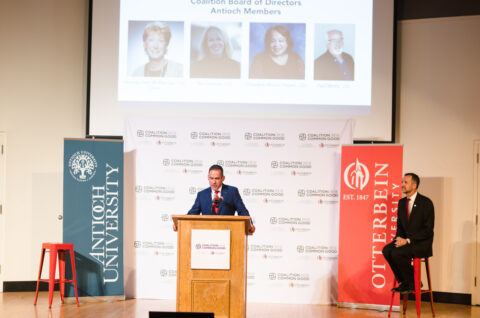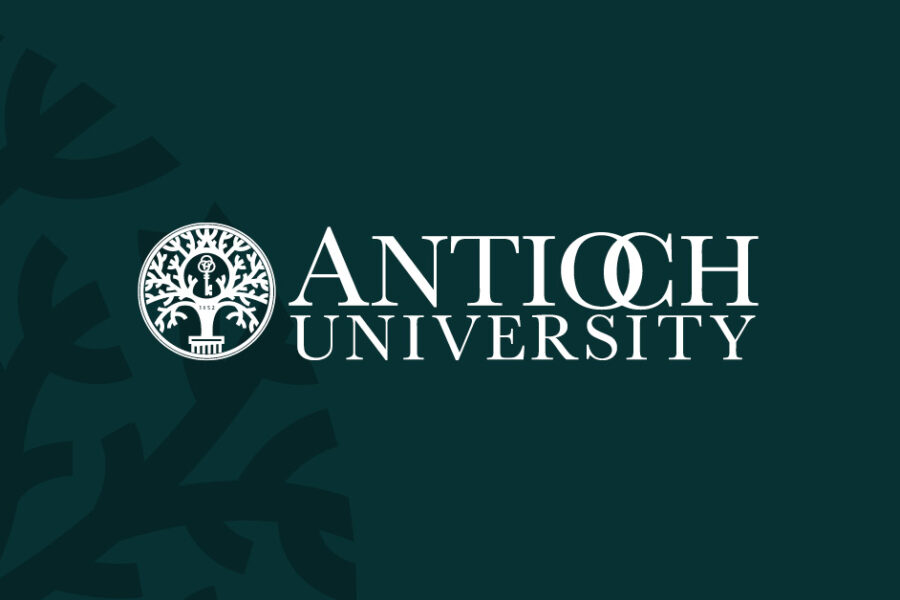On the morning of August 15, 2023, Antioch University and Otterbein University announced that they had officially created and become the first two member institutions in a new university system called the Coalition for the Common Good. At a signing ceremony later that day, the leaders of the two institutions emphasized what a momentous day it was: they had founded the first national system of affiliated universities organized around a shared mission of educating students to advance their careers and also promoting the common good, including preserving and improving our pluralistic democracy and advancing social, racial, economic, and environmental justice.
“Higher education owes our nation more than career preparation,” said Chancellor Bill Groves. “It requires that we educate students to be engaged global citizens and critical thinkers who are seekers of facts and truth, who are respectful of history, scholarly research, and science, and who are advocates for democracy, civil rights, human rights, and the rule of law.” He emphasized the divisive nature of contemporary politics and the many ways that higher education is under attack for its work in building diverse, equitable, and inclusive communities. And he was emphatic that the Coalition for the Common Good will stand against the forces undermining these core values. “There can be no social justice without democracy,” said Groves, “so Antioch University and Otterbein University are proud to lead in this important work.”
Otterbein President John Comerford shared this enthusiasm, and he emphasized the way that this mission is shared through the communities that make up the first two member institutions. As he said, “What we have built is not a top-down thing from the Boards or the Presidents or the Chancellors. It is a ground-up thing being led by the people that do the work on both of our campuses and university communities, and that is a really exciting thing to be a part of.”
As the ink dried on the agreement, the next stages of building out and fulfilling the promise of this new structure could get under way. “We are poised to begin all the work that’s necessary to get the dreams that we have aspired to here off the ground,” said Chancellor Groves. “It’s been a long time coming.”

Mission-Driven From the Start
Planning for a potential affiliation began in earnest in October, 2018 at a Board and faculty retreat in Los Angeles. The first conversations within Antioch’s Board of Governors emphasized the importance of finding partner institutions that shared Antioch’s mission and values. Longtime Board member Bill Plater put it clearly in one of these preliminary discussions. “What we really want to do,” he said, “is not create just a system, but a Justice League.”
Soon, Antioch University was engaging its investment banking firm, the Royal Bank of Canada, to come up with a process to seek out the first affiliate partner in this proposed system of mission-aligned universities. The administrators involved drew up their criteria for vetting potential university partners. As Chancellor Groves explains, “The vision was: growing geographically, building programs, scaling up programs across locations, expanding access for students, creating fast-track pathways from undergraduate to graduate programs, developing business partnerships for workforce learning opportunities. But also affiliating with schools that had our shared mission, so that mission would always remain central.”
Otterbein University emerged during the process as a potentially ideal partner with which to found what would become the Coalition for the Common Good. Otterbein and Antioch are quite different in the key variable of student demographics: Otterbein serves mostly traditional undergraduates on its campus in Ohio, while Antioch’s five campuses across the country serve an adult student body that skews strongly towards graduate and professional students, many of whom study in low-residency or fully-online programs. In this way, they fill different niches in the higher education space, not directly competing. (Antioch College, which served a traditional undergraduate student body, was closed by Antioch University in 2008; the campus re-opened in 2011 with the same name of Antioch College but now as a completely separate and unaffiliated institution from Antioch University.)

In other ways, though, Antioch University and Otterbein are uncannily similar. Otterbein was founded in 1847 and Antioch in 1852. Both institutions were among the first universities to welcome women and Black students, before the Civil War, the 19th Amendment, or the Civil Rights Movement. Both universities were shaped in part by student movements in the 1960s. On more mundane levels, they are comparable, too: Otterbein enrolls around 2,600 students, Antioch around 3,400; Otterbein has a budget of $64M, Antioch has one of $74M. Most importantly, both share a mission of serving society and promoting democracy.
Because of their similarities, leaders on both sides realized that joining forces could create a “partnership of equals” with strong mission alignment. And at the same time, their differences created potential for collaborations including degree pathways and reaching new markets.
This vision formed the basis for the preliminary deal that was signed July 14, 2022. (See “Antioch Plans Affiliation With Otterbein to Create First-of-Its-Kind System” from last year’s Antioch Alumni Magazine.) Over the following thirteen months, pursued all the necessary regulatory approvals, and many more details underpinning the affiliation were hammered out. The joint team submitted to their institutional accreditor, the Higher Learning Commission, an over 3,000-page application that assured the accreditors that they could continue to live up to the legal, financial, academic, and governance commitments required for accreditation. In April and May, the Higher Learning Commission visited both Antioch and Otterbein, and this site visit led to an enthusiastic approval of the transaction in June. The transaction closed on June 30, 2023, with a final signing ceremony on August 15, 2023.
This fall, a joint committee of faculty, staff, and students from both institutions came together to write out the Coalition’s first mission statement. Reflecting the values that initially brought the two institutions together, it reads:
The Coalition for the Common Good is a network of affiliated private, nonprofit colleges and universities that, through collaboration and integration, provide transformative education and lifelong learning. Together, we are dedicated to promoting the common good, including democracy, social justice, equity, inclusion, and engaged global citizenship.
As Chancellor Groves says, “This is not just a business proposition. We are focusing this unique system on the essential and important role that higher education plays in building and sustaining democracy.”
New Board Seated
The vision for this new national system does not stop with the two founding members. The effort is already underway to expand the system to include more mission-aligned institutions that will extend the geographical reach of the Coalition and expand the breadth of its portfolio of academic programs and other opportunities for students.
For now, though, the nine-member Board of Directors is composed of four members each from Antioch and Otterbein, with a final member unaffiliated with either institution. The board members drawn from Antioch’s Board of Governors are Holiday Hart McKiernan, Charlene Moore Hayes, Paul Mutty, and Teri Cannon. Those drawn from Otterbein’s Board of Trustees are Daniel C. Gifford, Peggy Ruhlin, Rev. April Casperson, and Theresa Harris. McKiernan is serving as the first board president.
The ninth board member was the last to be announced, because the other eight had to vote on who that would be. But the goal was to secure a member with deep knowledge and understanding of the higher education landscape, someone well known among higher education colleagues, and someone committed to the role of education in sustaining democracy, here and around the globe. The final selection was universally hailed as an excellent addition: the noted advocate for a liberal arts education Lynn Pasquerella. Pasquerella is the president of the American Association of Colleges and Universities, the author of What We Value: Public Health, Social Justice, and Educating for Democracy, and the former president of Mount Holyoke College. As McKiernan says, “Lynn brings incredible expertise as a renowned leader and scholar on the role of American higher education in advancing the common good and preparing students for engagement in a participatory democracy.”
“There is likely no stronger voice than Lynn Pasquerella on the importance of education in the future of our democracy,” says Otterbein’s President Comerford. “She is a passionate advocate for exactly what the Coalition was created to do—open the doors of higher education wide for those underserved by our existing education systems. We are truly thrilled to have her expertise, experience, and national network of contacts on our Board.”
In early November, the Coalition Board officially met in person for the first time, on Otterbein’s campus. They were updated on many of the plans, meetings, and other endeavors already being produced by faculty, administrators, and staff of the institutions now joined together under the umbrella of the Coalition for the Common Good.
New Plans Taking Shape
The launch of the Coalition is leading to a wide array of new programs, undergraduate-to-graduate pathways, and other collaborations. Various workgroups are meeting regularly over Zoom to move plans forward, and there have been in‐person visits by faculty and administrator teams from both universities to Ohio, Seattle, Los Angeles, and New Hampshire.
One big shift is that Antioch is taking over and expanding Otterbein’s graduate nursing, allied health, and athletic training programs. They will form the basis of Antioch’s new Graduate School of Nursing and Health Professions. A national search is presently underway for that school’s founding dean.
Meanwhile, a cross-institutional team has been working together for over a year to design a joint MBA. The working group has included both Antioch and Otterbein business and management faculty, along with appropriate academic administrators. “It has been a great experience,” says Steve Osborne, chair of Otterbein’s Department of Business, Accounting, and Economics. “We are finding so much in common and so many opportunities ahead.”
Several other Antioch programs are expanding into Ohio, including the Doctor of Education and Clinical Mental Health Counseling programs. Alongside these program expansions, strategic partnerships with different businesses and nonprofit organizations in Central Ohio and elsewhere have been announced, and there are plans to offer more specially-tailored workforce development programming in the future.
In a tangible benefit to students, pathways allowing students to combine an Otterbein undergraduate degree with an Antioch graduate degree are being rolled out for Fall 2024. The first, a pathway into Antioch’s Clinical Mental Health Counseling program, is already in place. Other pathways, including into Antioch’s MBA and Art Therapy programs are in the works. These Graduate Early Admission Pathways offer myriad benefits both to students and to their institutions. They allow high school students to see a clear path to career outcomes even before they begin their undergraduate studies, and they reduce the student’s cost and time to completion of their master’s degree. At the same time they provide Otterbein with a set of distinctive programs to drive student interest and enrollment, and they provide Antioch with a new stream of graduate students.
With all of the work that goes into it, these initiatives and more are taking shape—and each in its way is delivering on the bigger promise of the Coalition. As at-large Coalition Board member Pasquerella says, “The Coalition for the Common Good offers an exciting, innovative model of excellence for revolutionizing and reimagining higher education in ways that position all students for success in work, citizenship, and life in the 21st century.”




